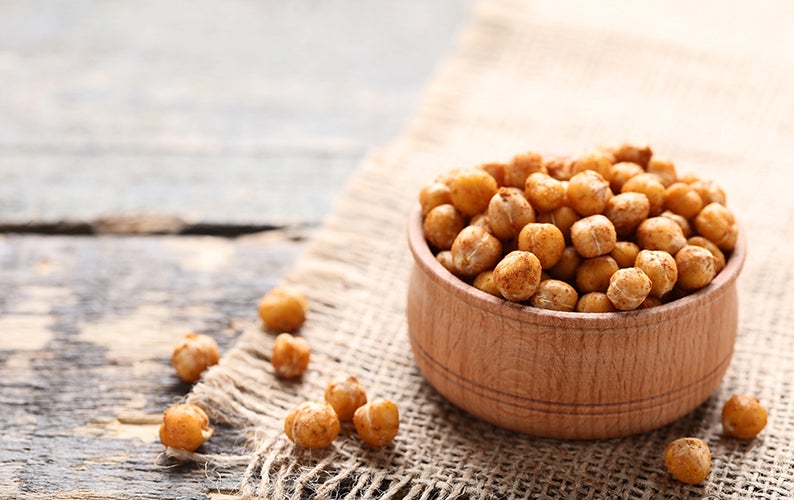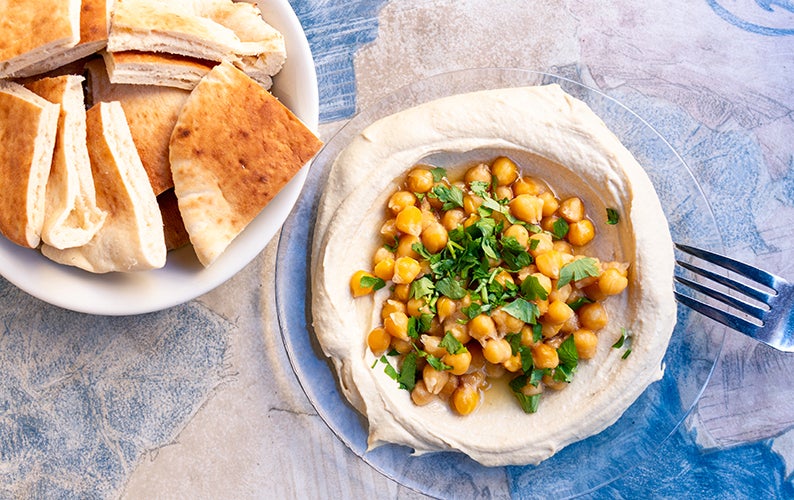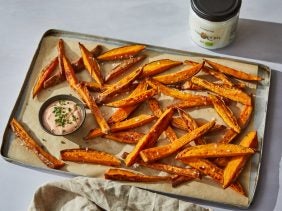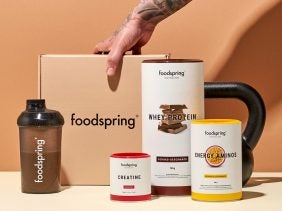Let’s Talk About Chickpeas – nutrition, history and how to cook them
 ©5second
©5second
Eating chickpeas for any meal is a surefire way to put yourself in a good mood! Not only is the humble little legume packed with essential vitamins and minerals, it’s easy to prepare and totally delicious. Find out how you can use the bean to make your life easier ASAP.
What are chickpeas?
Whether you know them as chickpeas or garbanzo beans, this humorously named ingredient is full of essential nutrients like protein, fiber, and complex carbohydrates. It’s truly a powerhouse!
Chickpeas belong to the legume family which is, like lentils, beans, and peas, why they’re rich in protein and fiber. In fact, the Eatwell Guide notes that eating legumes (or pulses, as they’re also known) counts towards one of your five-a-day. After all, they’re a great source of fiber — not to mention, they’ll keep you regular.
There’s an amusing, and interesting, history behind the name of the chickpea. In Latin, it was originally called cicer (pronounced kiker) which simply means pea or bean. As time passed by, it shifted to chiche in French, which made its way to chiche pease in English, which finally evolved to the word we know and love today. That means now, when we say chickpea, we’re basically saying “pea pea”! Meanwhile, in German, the word kiker evolved into kicher, which also means to giggle. So our pea-peas are Germany’s gigglepeas!
Speaking of chickpeas’ origins, research suggests that they were first cultivated in South Asia around 8000 years ago. Their continued cultivation throughout several millennia encouraged their journey into surrounding countries, which is why chickpea-based recipes can be found in Middle Eastern, Mediterranean, and Indian cuisine today, as well as in supermarkets around the globe.
Head to your local supermarket and you’ll certainly be able to find them (though they may be called something else depending on what country you’re in). In your local store, chickpeas may be available either dried or cooked and canned.
While the type of garbanzo beans you’ll find in Europe will probably be brown, there are tons of varieties you’ll have to go abroad to try. Like in India, where the most common type of chickpeas is green, slightly smaller, and more wrinkled — and an absolutely fantastic base for a piping hot bowl of chana masala.
Where and how do chickpeas grow?
As the demand for chickpeas goes up, more and more countries are racing to satisfy the consumers’ desires. Chickpeas are now grown everywhere from North Africa, Afghanistan, and Pakistan to Mexico, Australia, Spain, and Turkey. Harvesting them can be tricky, as the tiny beige balls have a tendency to hide behind the leaves of the one-meter-tall, herbaceous plant they grow on.
Chickpeas, as we know and eat them, are the edible seeds of a plant and are found in sets of two or three in green pods about three centimeters long. Luckily, cicer arietinum, the plant that produces chickpeas, is not very difficult to maintain. It doesn’t need much water, but does need heat, which is why in general it’ll have a better chance in a subtropical climate. In cooler climates, without the heat, the yield of chickpeas may be relatively low.
Nutritional value of chickpeas
Vegans, vegetarians, and fitness junkies alike love chickpeas because of how protein-dense they are. The fact that they’re also low in fat and calories certainly doesn’t hurt either. And there are fun and delicious ways to cook them into all of your meals — breakfast, lunch, dinner, and even dessert.
The low calorie content is compensated for by its high nutrient content. These little powerballs are rich in vitamins, minerals, and fiber.
100g of chickpeas (dry)
| Calories | 310 calories |
| Fat | 6 grams |
| Carbohydrates | 44 grams |
| Protein | 19 grams |
| Fiber | 16 grams |
| Sugar | 2 grams |
| Minerals | 2.9 grams |
100g of chickpeas (cooked)
| Calories | 119 calories |
| Fat | 2 grams |
| Carbohydrates | 17 grams |
| Protein | 9 grams |
| Fiber | 10 grams |
| Sugar | 1 gram |
| Minerals | 0.9 grams |
Benefits of chickpeas
Because they contain a lot of fiber, garbanzo beans are as good at filling you up as they are emptying you out. Eating them regularly can ensure satiety and improve your digestion, and is even known to help alleviate digestive disorders.
There’s also some research that suggests that fiber may even help reduce cholesterol levels. The saponins they contain may also improve your immune system and help your body fight off bacterial infections. And their anti-inflammatory properties have been shown to reduce blood lipids and protect the heart and circulation.
These aren’t the only reasons to love these legumes. They’re also loaded with minerals, bone- and teeth-strengthening calcium and phosphorus, and magnesium, which is essential for maintaining muscle and nerve function.
Last but not least, they also contain vitamin E, which is known for its ability to protect cells. This vitamin is also sold in pill form, and can be ingested or used topically. Many people swear by it as a natural remedy against aging.
Though we may have already mentioned this, it’s worth repeating how big of a boon chickpeas are to vegetarians and vegans. As an excellent source of protein, it’s an ideal alternative to meat. For a quick comparison, 100 grams of chicken breast contains approximately 20 to 24 grams of protein, 100 grams of salmon contains 18 to 20 grams of protein, and 100 grams of cooked chickpeas contain 9 grams of protein. Not exactly the same amount, but closer than a lot of other plant-based protein sources. Between the fiber, protein, and vitamins, what’s not to love about this bean?
Our tip: For anyone who has difficulty meeting their daily protein demands, our Vegan Protein will make it easy to get what you need. It contains pea, hemp, rice, and sunflower protein, and is completely free of soy — ideal whether you have a soy allergy or not. Just add water whenever you need a protein boost.
How to prepare chickpeas
Every chickpea lover knows just how versatile the legume can be and has probably cooked it many different ways. But for those of you just beginning your chickpea adventure, let’s discuss some of the most beloved recipes out there.

Because of where and how it originated and spread, it’s a common ingredient in Middle Eastern food, and can be found in hummus, falafel, and various other dishes. In India, it’s typically cooked into a stew, and in Italy into pasta. Nowadays food bloggers everywhere make everything from fried to roasted chickpeas. Wherever you look, it’s not difficult to find chickpea inspiration. And did you know? The cooking liquid, called aquafaba, can be used as a replacement for egg whites in several fluffy recipes such as meringues and mousses!
And there’s only one rule for eating chickpeas: Make sure they’re fully cooked beforehand! Aside from being too hard to eat when they’re dry, uncooked chickpeas contain toxins like lectins which can cause food poisoning. Plus, cooking cooked chickpeas again will only make them better.
Cooking dried chickpeas may be a little challenging because of how long they take to prepare. And if you’re not familiar with the process, you may undercook them without even realizing. Instead, we recommend playing it safe and sticking with canned chickpeas to get started. Once you feel ready to try out dried chickpeas, be sure to give yourself enough time. It’s important to let the chickpeas soak in water for ten to twelve hours before you start preparing them because that will shorten the overall cooking time (a good rule of thumb is to start soaking them before you go to bed. They’ll be ready by morning). Then, drain and rinse the beans, transfer them to a pot along with water and any spices, oils, or veggies you want to include to add flavor, and let them simmer over a low heat until they’re tender and creamy — usually a few hours, though be sure to taste as you go along. If you can easily prick them with a knife, they’re ready to eat.
Chickpeas: Our conclusion
- Chickpeas are extremely nutrient-dense.
- Among other things, these legumes provide essential minerals such as calcium and magnesium.
- Because of the fiber they contain, chickpeas promote satiety and healthy digestion.
- Low in calories, chickpeas are a useful tool for weight loss.
- Due to their high protein content, chickpeas are known to be a good alternative to meat, especially by vegetarians and vegans.
- Because they contain toxins when uncooked, chickpeas cannot be eaten raw. However, they are completely edible once cooked.
Sources for this article
We at foodspring use only high-quality sources, including peer-reviewed studies, to support the facts within our articles. Read our editorial policy to learn more about how we fact-check and keep our content accurate, reliable, and trustworthy.
































